When it comes to compact SUVs, the Subaru Crosstrek and Suzuki Vitara stand out as popular choices for drivers seeking versatility and performance. With both vehicles boasting unique features and cutting-edge technologies, this comparison will delve into their technical aspects and innovations, ultimately assisting you in making an informed choice.
Subaru Crosstrek vs Suzuki Vitara – Performance, range & efficiency compared
Both models have their strengths – but which one suits you more?
Compare performance, efficiency, price and space directly: Subaru Crosstrek or Suzuki Vitara?
Performance and Powertrain
The Subaru Crosstrek for 2024 is equipped with a 2.0-liter petrol MHEV engine producing a solid 136 HP and 182 Nm of torque. This power is transmitted through a smooth Continuously Variable Transmission (CVT) and is complemented by Subaru's renowned all-wheel-drive system, enhancing the vehicle's capability in varying terrains. The Crosstrek achieves a respectable 0-100 km/h acceleration in 10.8 seconds and has a top speed of 198 km/h, making it a robust choice for both city driving and off-road adventures.
On the other hand, the Suzuki Vitara offers multiple engine options, including petrol MHEV and full hybrid variants, with horsepower ranging from 116 to 129 HP. An appealing feature of the Vitara is its choice of transmission: potential buyers can opt for either a manual gearbox or an automated manual. The Vitara’s acceleration is commendable, with times ranging from 9.5 seconds to 12.7 seconds, depending on the engine choice. However, its top speed reaches 190 km/h, slightly below that of the Crosstrek.
Fuel Efficiency
For the environmentally-conscious driver, fuel consumption is a critical factor. The Subaru Crosstrek has a consumption rate of 7.7 L/100 km, which, while acceptable, lags behind the Suzuki Vitara's impressive figures that range from 5.0 to 5.6 L/100 km, depending on the variant. This makes the Vitara not only a cost-effective option but also a more eco-friendly choice with lower CO2 emissions, falling into categories D and C, compared to the Crosstrek's F class.
Dimensions and Cargo Capacity
In terms of size, the Subaru Crosstrek measures 4495 mm in length, 1800 mm in width, and 1600 mm in height, yielding a trunk capacity of 315 liters. This SUV comfortably seats five passengers and handles a curb weight between 1612 kg and 1628 kg. In contrast, the Suzuki Vitara is slightly more compact, measuring 4185 mm in length, 1775 mm in width, and 1595 mm in height, with cargo space between 289 to 375 liters. The lighter curb weight, ranging from 1255 kg to 1395 kg, gives the Vitara a nimbleness that can enhance its maneuverability in urban settings.
Interior Features and Innovations
Both models offer a range of interior amenities that appeal to modern drivers. The Subaru Crosstrek comes equipped with user-friendly technology, including a touchscreen infotainment system with smartphone integration, making it easy to stay connected on the go. Comfort features such as supportive seats and a well-laid-out dashboard enhance the overall driving experience.
Meanwhile, the Suzuki Vitara shines with its driver-assistance technologies, including adaptive cruise control and lane-keeping assist, positioning it as a safer option for families and commuters alike. Additionally, its modern cabin design is bolstered by high-quality materials and an intuitive infotainment system, ensuring convenience for all passengers.
Conclusion
In conclusion, the Subaru Crosstrek and Suzuki Vitara each bring their own strengths to the table. The Crosstrek offers robust off-road capability and powerful engine performance, while the Vitara excels in fuel economy and a lighter, more versatile design. Your ultimate choice will likely hinge on your specific driving needs—whether you prioritize off-road adventures or daily commuting efficiency, both models are worthy contenders in the compact SUV market.
Here’s where it gets real: The technical differences in detail
Costs and Efficiency:
Price and efficiency are key factors when choosing a car – and this is often where the real differences emerge.
Suzuki Vitara has a noticeable advantage in terms of price – it starts at 23600 £, while the Subaru Crosstrek costs 29800 £. That’s a price difference of around 6249 £.
Fuel consumption also shows a difference: Suzuki Vitara manages with 5 L and is therefore convincingly more efficient than the Subaru Crosstrek with 7.70 L. The difference is about 2.70 L per 100 km.
Engine and Performance:
Power, torque and acceleration say a lot about how a car feels on the road. This is where you see which model delivers more driving dynamics.
When it comes to engine power, the Subaru Crosstrek has a minimal edge – offering 136 HP compared to 129 HP. That’s roughly 7 HP more horsepower.
In acceleration from 0 to 100 km/h, the Suzuki Vitara is to a small extent quicker – completing the sprint in 9.50 s, while the Subaru Crosstrek takes 10.80 s. That’s about 1.30 s faster.
In terms of top speed, the Subaru Crosstrek performs slight better – reaching 198 km/h, while the Suzuki Vitara tops out at 190 km/h. The difference is around 8 km/h.
There’s also a difference in torque: Suzuki Vitara pulls distinct stronger with 235 Nm compared to 182 Nm. That’s about 53 Nm difference.
Space and Everyday Use:
Cabin size, boot volume and payload all play a role in everyday practicality. Here, comfort and flexibility make the difference.
Both vehicles offer seating for 5 people.
In curb weight, Suzuki Vitara is distinct lighter – 1255 kg compared to 1595 kg. The difference is around 340 kg.
In terms of boot space, the Suzuki Vitara offers a bit more room – 375 L compared to 315 L. That’s a difference of about 60 L.
In maximum load capacity, the Subaru Crosstrek performs a bit better – up to 1314 L, which is about 194 L more than the Suzuki Vitara.
When it comes to payload, Subaru Crosstrek noticeable takes the win – 505 kg compared to 400 kg. That’s a difference of about 105 kg.
Who comes out on top?
Overall, the Suzuki Vitara shows itself to be wins the duel decisively and secures the title of DriveDuel Champion.
It convinces with the more balanced overall package and proves to be the more versatile choice for everyday use.
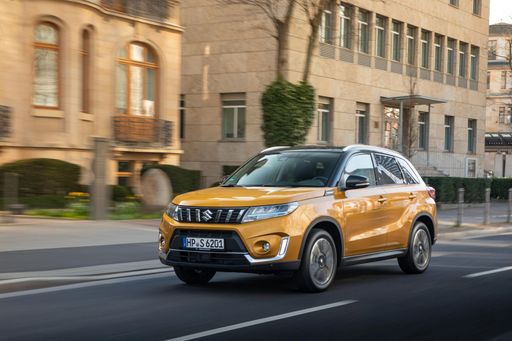 @ Suzuki Motor Corporation
@ Suzuki Motor Corporation
Suzuki Vitara
Subaru Crosstrek
The Subaru Crosstrek stands out in the compact SUV market with its rugged design and excellent off-road capabilities. Its versatile interior space and comfortable seating make it a great choice for both city commutes and weekend adventures. Coupled with Subaru's renowned all-wheel-drive system, the Crosstrek offers a dynamic driving experience for those seeking reliability and performance.
detailsSuzuki Vitara
The Vitara is a city-smart SUV with a cheeky streak of off-road promise, perfect for drivers who want practicality without pretense. It’s honest, easy to live with and surprisingly likeable, a sensible companion for everyday adventures and weekend escapes.
details @ Suzuki Motor Corporation
@ Suzuki Motor Corporation
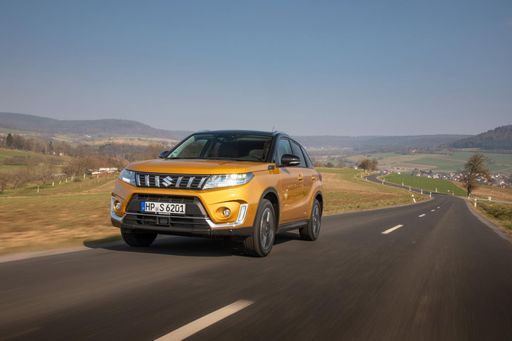 @ Suzuki Motor Corporation
@ Suzuki Motor Corporation
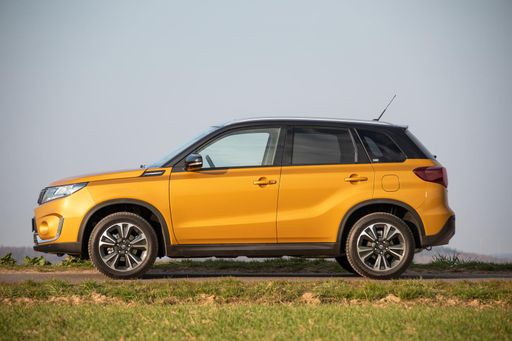 @ Suzuki Motor Corporation
@ Suzuki Motor Corporation
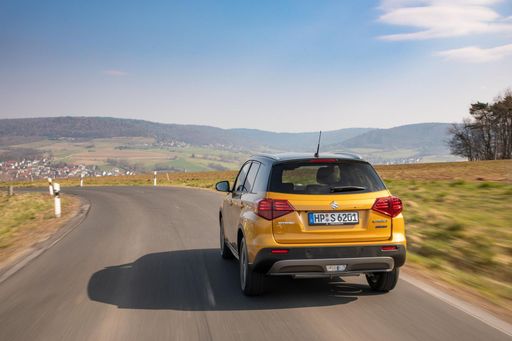 @ Suzuki Motor Corporation
@ Suzuki Motor Corporation
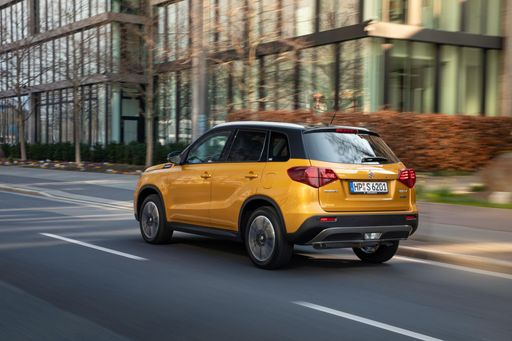 @ Suzuki Motor Corporation
@ Suzuki Motor Corporation
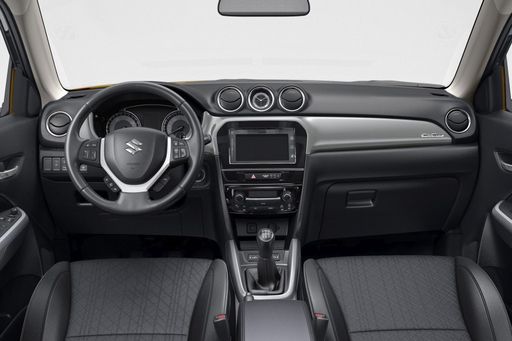 @ Suzuki Motor Corporation
@ Suzuki Motor Corporation
 @ Suzuki Motor Corporation
@ Suzuki Motor Corporation
|
|
|
|
|
Costs and Consumption |
|
|---|---|
|
Price
29800 - 34900 £
|
Price
23600 - 30900 £
|
|
Consumption L/100km
7.70 L
|
Consumption L/100km
5 - 5.9 L
|
|
Consumption kWh/100km
-
|
Consumption kWh/100km
-
|
|
Electric Range
-
|
Electric Range
-
|
|
Battery Capacity
-
|
Battery Capacity
-
|
|
co2
174 g/km
|
co2
113 - 138 g/km
|
|
Fuel tank capacity
48 L
|
Fuel tank capacity
47 L
|
Dimensions and Body |
|
|---|---|
|
Body Type
SUV
|
Body Type
SUV
|
|
Seats
5
|
Seats
5
|
|
Doors
5
|
Doors
5
|
|
Curb weight
1595 - 1628 kg
|
Curb weight
1255 - 1395 kg
|
|
Trunk capacity
315 L
|
Trunk capacity
289 - 375 L
|
|
Length
4495 mm
|
Length
4185 mm
|
|
Width
1800 mm
|
Width
1775 mm
|
|
Height
1600 mm
|
Height
1595 mm
|
|
Max trunk capacity
1297 - 1314 L
|
Max trunk capacity
1046 - 1120 L
|
|
Payload
472 - 505 kg
|
Payload
375 - 400 kg
|
Engine and Performance |
|
|---|---|
|
Engine Type
Petrol MHEV
|
Engine Type
Petrol MHEV, Full Hybrid
|
|
Transmission
Automatic
|
Transmission
Manuel, Automatic
|
|
Transmission Detail
CVT
|
Transmission Detail
Manual Gearbox, Automated Manual, Automatic Gearbox
|
|
Drive Type
All-Wheel Drive
|
Drive Type
Front-Wheel Drive, All-Wheel Drive
|
|
Power HP
136 HP
|
Power HP
110 - 129 HP
|
|
Acceleration 0-100km/h
10.80 s
|
Acceleration 0-100km/h
9.5 - 12.7 s
|
|
Max Speed
198 km/h
|
Max Speed
180 - 190 km/h
|
|
Torque
182 Nm
|
Torque
235 Nm
|
|
Number of Cylinders
4
|
Number of Cylinders
4
|
|
Power kW
100 kW
|
Power kW
81 - 95 kW
|
|
Engine capacity
1995 cm3
|
Engine capacity
1373 - 1462 cm3
|
General |
|
|---|---|
|
Model Year
2024
|
Model Year
2024 - 2025
|
|
CO2 Efficiency Class
F
|
CO2 Efficiency Class
D, C, E
|
|
Brand
Subaru
|
Brand
Suzuki
|
What drive types are available for the Subaru Crosstrek?
The Subaru Crosstrek is available as All-Wheel Drive.
The prices and data displayed are estimates based on German list prices and may vary by country. This information is not legally binding.
